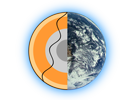Speaker
Dr
Hiroko Watanabe
(Tohoku University)
Description
The **Kam**ioka **L**iquid-scintillator **A**nti-**N**eutrino **D**etector (KamLAND) is located in a rock cavern in the Kamioka mine, 1,000 m below the summit of Mt. Ikenoyama in Japan. KamLAND is marked by the ability to detect low-energy anti-neutrino signals at 1,000 tons of ultra pure liquid scintillator through the inverse \beta reaction, \bar{\nu}_{e} + p \rightarraw e + n. We demonstrated the oscillation nature of neutrino flavor transformation by observing electron anti-neutrino (\bar{\nu}_{e}) from nuclear reactors and neutrino properties have been explored precisely. Since neutrinos interact with other particles only via weal interaction, they have extremely low reaction probabilities. Such elusive property of neutrinos provides us with the ability to investigate optically invisible deep interior of the astronomical objects, such as the Earth. Neutrino measurement evolved understanding of neutrino properties to utilization of neutrino as a “probe”.
The detection of geo-neutrinos, \bar{\nu}_{e}’s produced in \beta-decays from primordial radioactive elements (uranium, thorium and potassium) within the Earth’s interior, brings unique and direct information about the Earth’s interior and thermal dynamics. KamLAND detects geo \bar{\nu}_{e} signals above 1.8 MeV due to the reaction threshold energy of the inverse \beta-decay, resulting to have sensitivity to \bar{\nu}_{e}’s from the decay chains of ^{238}U and ^{232}Th. The KamLAND collaboration reported the result of the first study of geo \bar{\nu}_{e} in 2005. Later the geo \bar{\nu}_{e} signals at KamLAND were used to estimate our planet’s radiogenic heat production and constrain composition models of the bulk silicate Earth (BSE). Following the Fukushima nuclear accident in March 2011, the entire Japanese nuclear reactor industry, which generates >97% of the reactor \bar{\nu}_{e} flux at KamLAND, has been subjected to a protracted shutdown. This unexpected situation allows us to improve the sensitivity for geo \bar{\nu}_{e}’s.
Currently, geo \bar{\nu}_{e} observed rate is in agreement with the prediction from existing BSE composition models within 2\sigma C.L., but some extreme models start to be disfavored. This ability to discriminate is limited by the experimental uncertainty and crust modeling. Continuing the data taking under the present low-reactor situation yields better signal-noise ratio and provides promising power of uncertainty (21% \rightarraw 15% with 5-year measurement). Enhanced geo \bar{\nu}_{e} flux calculation model using latest crustal structure model and geochemical understanding around Japan Island Arc will be a key issue for the further constraint on the Earth models and observation of mantle contribution.
Primary author
Dr
Hiroko Watanabe
(Tohoku University)
